Having had a remarkable experience photographing a pair of Common Loons the last week of June last year, including having them show me their nest during an incubation exchange, one of my wishes for this summer was to try for a follow-up photo series that included recently hatched downy young loons. For a month I’ve been watching weather reports covering central Minnesota for a best-case opportunity to return to Little Pelican Lake to photograph a Common Loon family.
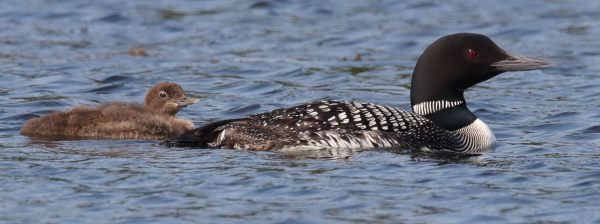
Finally, last Wednesday the weather showed an opening in the clouds on Thursday during the late afternoon hours – perfect. I quickly called my friend Andy, who was all for captaining a repeat loon photo session on his luxury pontoon boat; plus he noted that he saw 2 pairs of loons on the lake the previous weekend, each with a downy hatchling! “Now I’m excited,” I exclaimed to Andy and we made plans to meet at his lake home the following afternoon about 4pm, with the company of our friend Linda, a college friend from Hollywood who has a lake home not far away on Big Cormorant Lake.
It’s a 3-plus hour drive mostly eastward from my home, and although there were scattered clouds and more wind than I expected along the way, by the time I arrived at Little Pelican Lake, the sky was clearing and the wind at water level wasn’t much of a factor. Even before I reached Andy’s dock, I saw an adult and downy young Common Loon near shore, which elevated my excitement level all the more. It was great to greet Linda and Andy, and we hustled directly to the pontoon boat to start the water phase of this expedition.
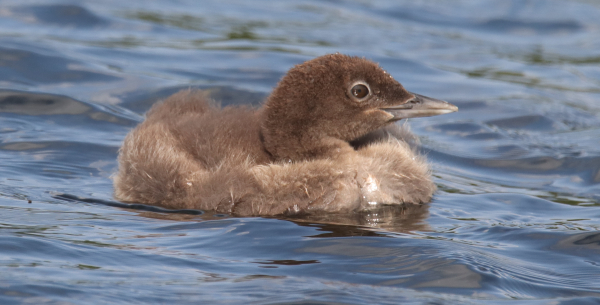
Andy was pleasantly excited for a repeat performance, having enjoyed our outing 13 months earlier with our buddy Dwight, and Linda was equally happy to be with us, having opted not to come along the summer before. Last year it took us about an hour to find a resident loon on the lake, but this year, we were photographing in less than 15 minutes!
Andy was now an experienced bird photography pontoon captain, so he quietly slipped into position between the sun and the loons, and we were in business, photographing a pair of adults with a downy hatchling that I figured was close to 3 weeks old. The downy loon was really special, although few Northwoods waterbirds can compare to the beauty and grandeur of adult Common Loons. To have a family group like this before us was tremendous. Using my 150-to-600mm zoom lens to zero in on the 3 loons, collectively and individually, we kept our distance to ensure the loons continued to behave naturally – and they were mostly unconcerned with us from start to finish.
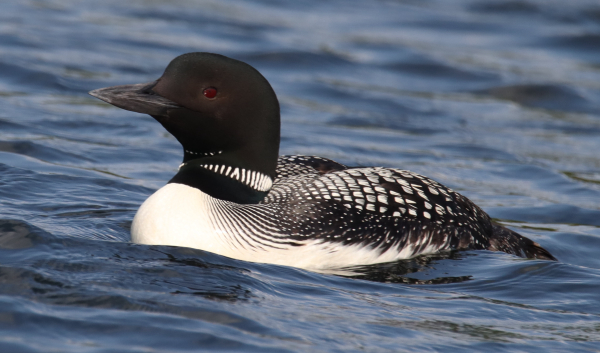
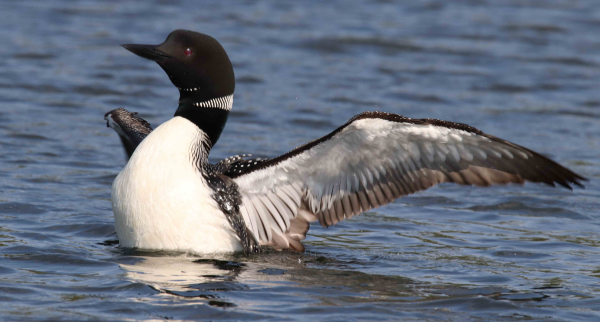
While I photographed, the female began fishing, starting by holding her face under the water to search for fish; then diving below and usually returning with a small fish for the downy young. Soon, the young loon began doing the same face plant into the lake, and it even did some diving, although I didn’t see that it was successful at catching a fish. Suddenly, the male raised its head high in a stiff-necked position and began calling; it was quite a thrill. Never before have I been so close to a loon as it gave its iconic loon call – the call of the wild in the Northwoods!
As I photographed the loons, although we were mostly stationary, the loons were almost always on the move, so the light changed a bit depending on where the birds moved as a family group. When the loons moved beyond a good lighting angle – sometimes swimming at a surprisingly quick pace – Andy would slowly reposition the remarkably quiet pontoon to an appropriate spot with the sun behind us and the loons before us so the photo session could continue. As I shared with Linda, “the shadow knows,” referring to how you can judge the best place to be positioned by checking to see that your shadow is pointing at the birds.

I was using my usual ISO 400 setting with the Mode set for Av (aperture priority), which allowed me to dictate the width of the depth of field by using a broad f-8 or f-10 aperture. With the aperture set, the camera set the corresponding shutter speed, which was usually very fast with the abundant late afternoon sunlight. I tended to use the broader f-10 aperture when trying to photograph 2 or 3 loons within the same frame, or when 2 loons were separated side to side.
It was hard to break away from such an enjoyable interaction with the loon family, but we didn’t want to overstay our welcome – and we were also interested in finding the second family group of loons. In just a couple moments, we observed what must have been a family group of Belted Kingfishers, with at least 3 and possibly 4 vocalizing and flying in an area centered on a couple prominent bare branches on the lakeshore. Around a point and into the next bay, we watched a pair of Ospreys interacting, calling and soaring low over the edge of the lake, and even providing me with a couple photo ops as one soared close enough.
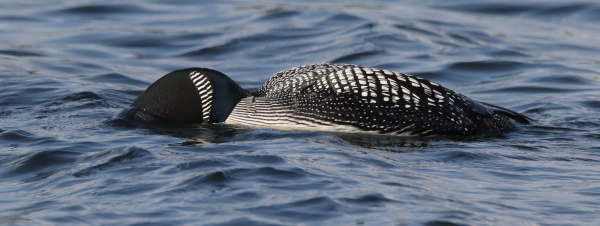
That’s about the time we sighted an adult loon with a downy hatchling that was less than a week younger than the first one – between 2 and 3 weeks old. Andy quietly slipped into position, turned off the engine, and I began photographing, focusing on the little one at first. In a couple minutes the second adult appeared, swimming in from behind us with a small fish in its beak. I photographed the food exchange, and made the most of the chance to photograph the family group together.
Throughout our time with the loons, Linda and Andy asked about the birds, and I tried to answer questions as best I could, but eventually needed to verify my life history descriptions with the best information available from field researchers, which is contained in the ultimate reference source for birds: Birds of the World. In short, Common Loons are long-lived birds that form pair bonds that last about 5 years on average, but are known to last 17 years in some cases. After incubating the usual 2 egg clutch for 4 weeks, newly hatched loons are covered with dense almost-black natal down, which is replaced when the hatchlings are about 12 days old by longer light-brown down. Therefore, as I suggested, both the downy loons were more than 2 weeks old.

Then, by week 3 feathers begin erupting, starting with the white feathers on the underside of the loon, which was true of the larger downy loon, suggesting it was between 3 and 4 weeks old. During week 4, feathers are said to begin showing on the young loons’ head; and if you look carefully at the photo of the larger downy loon (the seventh photo), you can see white feathers just beginning to show near the bill and around the eyes.
As I was planning this summer loon photo trip, I originally hoped to time my trip for about the first of July, soon after I expected the young loons would hatch. At that time the young loons would have blackish-colored down, and will ride on the back of the adults, usually the back of the male. But the weather and timing of my free days didn’t coincide, so as Andy noted, “We’ll do it again next year before on the 4th of July.” As it turns out, according to the info from Birds of the World, the blackish hatchlings only swim on an adult’s back for a very short period after hatching, essentially from when they are 1 to 2 weeks old – only 7 days or so – so that’s a tight window, but we’ll give it a try that first week of July. At the same time, I’m thinking it would be a good move to return to Little Pelican Lake to photo document the growth of the young loons as they grow and become feathered with their juvenile plumage next month.
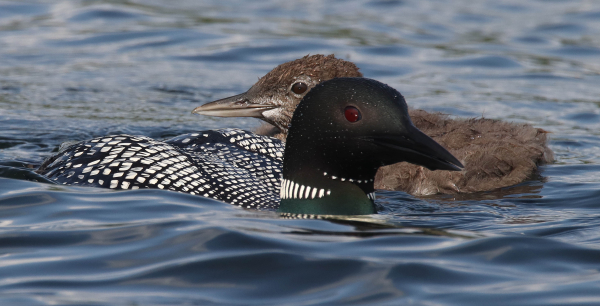
A crowning touch on this loon photo trip came a bit later that evening at Linda’s lakeshore home, when I heard a loon calling loudly – close – then saw it break through the cover of the trees. It was flying high on its long loon wings, calling as it flew directly away; and it was momentarily followed by a second silent loon. I watched their flight until they were mere lines against the sky, and again appreciated what an enjoyable time I had with Linda and Andy, amid such beautiful weather and surroundings, and some classic Northwoods birds – we all enjoyed sharing that memorable time together, and I’m sure we’ll do it again soon.
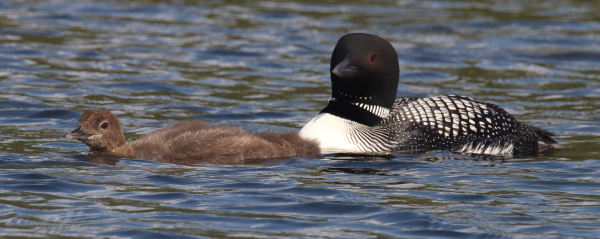
Article and photographs by Paul Konrad
Share your bird photos and birding experiences at editorstbw2@gmail.com